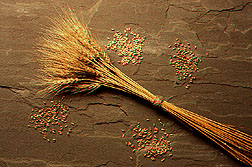This page has been archived and is being provided for reference purposes only. The page is no longer being updated, and therefore, links on the page may be invalid.
Read the magazine story to find out more. |
|
|
Helping Wheat Pass the Acid Test
By Ann PerryAugust 4, 2008
Many wheat farmers in the southern Great Plains states face a significant challenge: High levels of aluminum released in the acidic soils can stunt crop growth. So Agricultural Research Service (ARS) plant geneticist Guihua Bai leads a team that is improving the odds for cultivating wheat in these acidic soils.
Bai works at the ARS Plant Science and Entomology Research Unit, part of the agency's Grain Marketing and Production Research Center in Manhattan, Kan. His research includes finding aluminum-resistance genes in wheat that breeders could use to improve the resistance of regional varieties to aluminum toxicity.
Bai and Kansas State University colleagues Dadong Zhang and Shibin Cai created a wheat population by crossing "FSW," a Chinese wheat landrace known for its resistance to aluminum, with "ND35," a wheat line sensitive to elevated levels of aluminum in soils. They exposed the population to high aluminum levels to assess their resistance to aluminum toxicity.
The team assessed the effects of aluminum exposure on roots by measuring root growth and evaluating how effectively hematoxylin stained the root tissue. Hematoxylin is a natural dye that only stains root tissue after reacting to aluminum that has been drawn out of the soil and into the roots.
The researchers then compared patterns of 1,028 simple-sequence-repeat (SSR) markers between the two wheat parents and their offspring to identify relationships between markers and aluminum resistance among the offspring. SSR markers are short repeating segments of deoxyribonucleic acid (DNA) that are found in all chromosomes. Some SSRs are near the genes that confer beneficial traits in plants and can be used to locate these genes in experimental populations.
The scientists used the SSR map to locate two genes in FSW that together accounted for about 58 percent of its aluminum resistance. They also identified several SSR markers that are in close proximity to these genes. These SSRs could potentially be used to tag aluminum resistance genes for breeding aluminum-resistant wheat varieties.
Read more about this research in the August 2008 issue of Agricultural Research magazine.
ARS is a scientific research agency of the U.S. Department of Agriculture.

